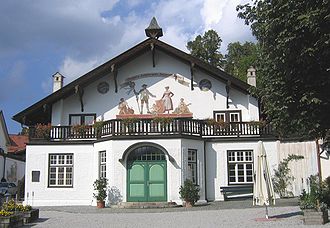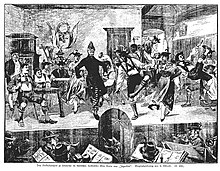Schliersee farmers theater
The Schlierseer Bauerntheater was the first Bavarian farmer's theater .
founding
The theater group was founded in Schliersee in 1892 by Konrad Dreher and Xaver Terofal . According to the plans of the Munich architect Emanuel von Seidl , a theater building was built in the same year that offered space for more than 450 visitors. The railway line , which had been opened a few years earlier, enabled guests to travel comfortably from Munich to Schliersee and attend the performance of folk plays there in a rural setting.
ensemble
In contrast to the custom at the time of also casting folk plays in dialect with academically trained actors , the Schliersee stage took a different approach: a group of actors and farmers was supposed to convey “real life” to life. Nevertheless, the ensemble worked full-time for the theater: in the summer season at the parent company in Schliersee and in the winter to guest performances in Germany, Austria and overseas. The ensemble included (1893) a. a. Xaver Terofal and daughter Anna, Willi Dirnberger and wife Therese (Miesbach), Mathias Gailing, Anna Keil, Marie Riedlechner, Sigmund Wagner, Jakob Weinisch (Schliersee), Michael Dengg (Rottach-Egern).
Guest appearances and travel
In addition to numerous guest appearances in Munich, Frankfurt, Nuremberg, Hamburg, Stuttgart and Vienna, the troupe embarked on a major American tour in 1895 . The performances at the Metropolitan Opera in New York are particularly noteworthy .
KdF and front stage
The rural drama and the way of life shown in it fit in well with the ideas of the Nazi rulers from 1933 onwards. As part of the National Socialist leisure organization “ Kraft durch Freude ” ( Kraft through Joy ), trips to Schliersee and visits to the farmers' theater were offered. The troops experienced an even stronger political instrumentalization when used as a "front stage" in the years 1939 to 1944. During this time, German troops in France, Russia, Greece and Poland were visited and entertained with performances of popular folk plays.
New beginning after the Second World War
After the end of the world war, the troops had to struggle with major economic problems. A fire in the parent company also made a break of two years necessary. The ensemble did not find its way back to its old size and could not build on the quality of the plays or the acting performance of earlier times, which, however, did little to change the popularity of the Schliersee farm theater today.
literature
- Julius Schaumberger: Konrad Dreher's Schliersee'r farmers theater. A picture of the time and the future. With 7 views of the area and the theater and 13 portraits of Konrad Dreher and the main actors. E. Albert & Co., Munich 1893.
- H ': Schlierseer Bauerntheater , in: Allgemeine Kunst-Chronik. Illustrated magazine for art, applied arts, music, theater and literature. Vol. 17. Munich 1893, pp. 494–497 (illustrations).
- Illustrirte Zeitung Leipzig, No. 2617, August 26, 1893, p. 239 (ill.).
- Ernst Georg Nied: Alpine rush and hunter's blood. The beginnings of professional Upper Bavarian peasant theater before the First World War , Munich 1986 (= Munich contributions to theater studies, vol. 17) [also phil. Dis.].
- Siegfried Weiß : The struggle for the remains - humor and social criticism in the work of the Munich painter Peter Baumgartner (1834–1911) and his relationship to the Upper Bavarian peasant theater . In: Pantheon, Munich 1999, pp. 203–207 (fig.).

